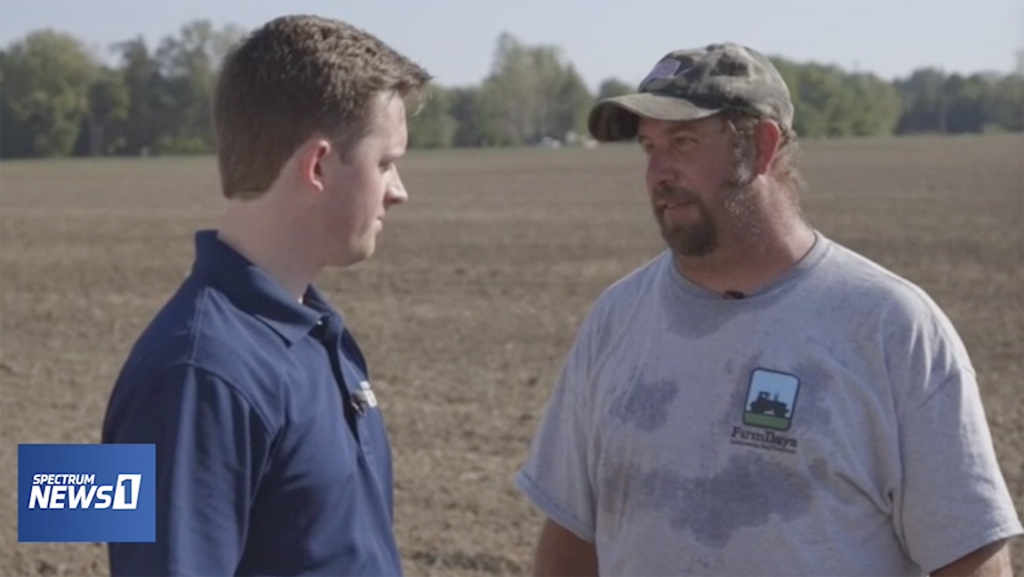
When Charter Communications executives needed someone to run their Spectrum News operation in Ohio, they found a candidate with just the right amount of TV experience.
None.
“I’m playing catch-up on the TV part,” says Karl Turner, who held senior editorial jobs at The Plain Dealer in Cleveland and cleveland.com. “And I’m helping to think about stories in a different way.”
“We hired him with zero video experience,” echoes Spectrum Networks EVP Mike Bair. “But we loved his ability to tell stories. We loved his knowledge of the marketplace. And we love that he had a fresh take on what people wanted to learn about.”

(Courtesy Charter Communications)
Spectrum News is building a reputation for “fresh takes” in the 16 new cable news operations it has launched around the country since October of 2018, including a just-announced service to cover Central and Western Massachusetts. We’ve told you about Spectrum News Southern California’s MMJ (multimedia journalist) and story-driven reimagining of local news in that sprawling market — “We don’t do car chases.” Spectrum News is now applying a similar model across entire states, including Kentucky and two Midwestern states, Ohio and Wisconsin.
The result: an unusual experiment that blends statewide, regional and local news. It’s a bet that the company can provide a compelling alternative to traditional TV news fare. “There’s no way we want to compete with the regular broadcasters,” says Bair. “When we went to the Midwest, we said we want the same tonal approach [as Southern California], which is NPR meets Vice meets [ESPN’s] 30 for 30.” And while this cable-only hybrid may be tempting for entrenched local players to dismiss, the Spectrum News approach has important lessons for any news director interested in challenging conventional formulas.

Here’s how the operation works. The newsroom in a hub city — Columbus for Ohio, Milwaukee for Wisconsin — produces an anchored linear feed for the whole state, with meteorologists delivering customized content to different regional channels. Ohio has five regions, Wisconsin three. Viewers in each region also get a customized “ticker” or crawl with local headlines.
MMJ’s are based throughout the state but are defined by their beats rather than their locations. Beats include state politics, economic development, health care, agriculture, immigration, education and veterans and first responders. The MMJ’s generally operate from their home bases rather than showing up in the newsroom. They’re encouraged to shoot and edit their stories creatively and offer them at the length they require rather than fitting a formula. (Try finding a 9:20 story on a day in the life of an Ohio farmer on a broadcast station.) Most importantly, the Spectrum News reporters are supposed to come up with distinctive stories that have statewide appeal — and a longer shelf life than the typical “breaking news” report.

“They’re telling stories from where they are, not about why they’re there,” says Jason Pheister, Spectrum’s Midwest VP. “The hope is and the goal is that when you’re watching in Cleveland, you get the things that are essential and important to you: your weather, your headlines, and then some really great, compelling stories that you’re not going to get from the local broadcast stations.”

(Courtesy Charter Communications)
“We’re not chasing car accidents or shootings or house fires or anything like that,” says Wisconsin News Director Diane Irving, who worked at Milwaukee’s WTMJ for 23-plus years. “Our emphasis is on original enterprise stories.” Irving and her colleagues are trying to chart their own course in what she calls the “sea of sameness” in local TV news. “I think you could be in any city on any given day, and most stations are all doing the same stories. And we almost never are.” “Every single day we are out there not wasting resources to chase the things that don’t matter,” says Pheister. “We’re trying to find the stories that do.”

The Spectrum executives admit that weaning their reporters off old habits hasn’t always been easy. “Most of our folks came from traditional newsrooms. And so to get them to think differently is challenging,” Jason Pheister says. “And they’re a little fearful because they’re used to just listening to that scanner traffic and someone saying ‘Go do,’” agrees Ohio’s Karl Turner. “Every time there was a cat stuck in a tree they had to go. And now they’re seeing that all their brainpower is unleashed on telling good stories that people can appreciate.”
I can hear local news directors in Ohio and Wisconsin’s tough competitive markets already. “Great. I’d like to see how long this experiment would last if Spectrum News had to worry about the February book.” It’s a fair point. Spectrum News exists to help convince cable subscribers not to cut the cord. The definition of victory Is not ratings or advertising rates or direct profits; instead, Spectrum News needs to make itself essential to its viewers in order to thrive. “Our role is to create long term engagement so people are watching us habitually,” says Bair, “and that’s where our value is. And that’s the model change that allows us to do some of these things that the others will not.”
But why won’t “others” do these things? Apples to apples comparisons may be tricky, but differentiation — such a critical part of the mission at Spectrum News — is a goal local broadcasters like to talk about too. So what about those lessons I mentioned earlier?
Here are three replicable ideas I took away from my conversations with the team:
1. Rely less on the scanner — emphasize relevance over recency and impact over immediacy.
2. Create beats staffed by experts who can address critical issues in the community.
3. Build unique value around reporters and storytelling rather than just newscasts.

The two statewide channels have only been around since November of 2018. Executives say they plan to invest in more local journalists and coverage as the operations grow; it will be interesting to see whether they feel the need to differentiate the regions more from one another rather than rely on customized weather forecasts and a crawl to say “local.” There will also be a hub in Florida for sharing content across all markets, along with an expanded bureau in Washington D.C.
As we reported last year, Spectrum News Buffalo was the first TV newsroom to recruit a beat reporter — in its case, a journalist to cover mental health issues — from the nonprofit Report for America. And Spectrum is bringing two more Report for America journalists to Orlando and Los Angeles this year, to report on housing and environmental sustainability respectively.
The company says it holds the Spectrum News operations accountable for creating an indispensable service for viewers. Mike Bair told me the news channels are in the top three for “engagement” — measured by the amount of time subscribers watch them compared to other channels — in every one of their markets.
Spectrum News Wisconsin’s Diane Irving talks about a different kind of accountability — a commitment by the organization’s journalists to change the way local TV news is done. “By and large, I think the people who came here came here because they wanted to do something different. They believed in this model that we were trying to do. They believed in trying to tell stories differently. They believed in enterprise reporting; they believed in issue-based reporting. And so to me, the cultural piece is us holding each other accountable to make sure that that we are living the mission.”